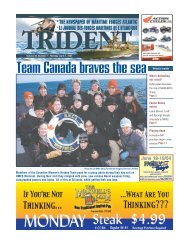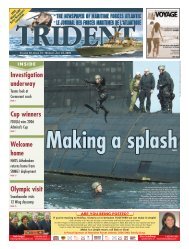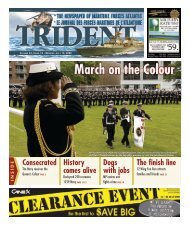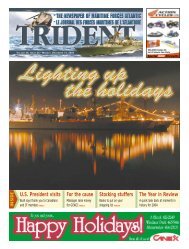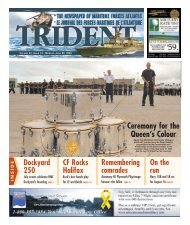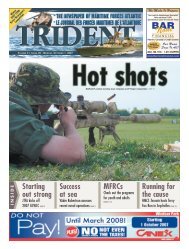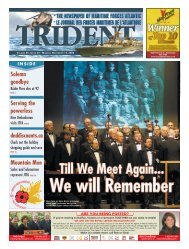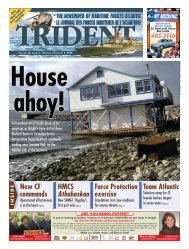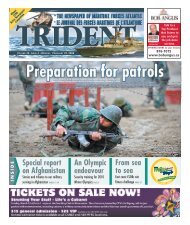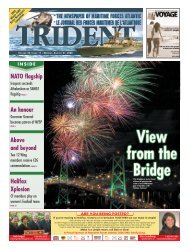Thank you Never again Clearing the air Lest we ... - Tridentnews.ca
Thank you Never again Clearing the air Lest we ... - Tridentnews.ca
Thank you Never again Clearing the air Lest we ... - Tridentnews.ca
Create successful ePaper yourself
Turn your PDF publications into a flip-book with our unique Google optimized e-Paper software.
TRIDENT, NOVEMBER 1, 2004 R E M E M B R A N C E D A Y S P E C I A L11Not <strong>the</strong> Slightest Chance: The Defense of Hong Kong,1941Bet<strong>we</strong>en<strong>the</strong> Linesby Laurel HalladayDNewsUniversity of British ColumbiaPress, Vancouver, Jan 2004.ISBN: 0774810459. Author: TonyBanham, 431 pages, $29.95 CDN(paperback).Although he would later order i<strong>the</strong>ld as long as possible, in <strong>the</strong>spring of 1941 Winston Churchillsummed up <strong>the</strong> prospects of successfullydefending Hong Kong<strong>again</strong>st a Japanese attack with <strong>the</strong>words “not <strong>the</strong> slightest chance.”Tony Banham’s amazingly <strong>we</strong>llresearched book adopts this phraseof gloomy foreshadowing as itstitle, and in methodi<strong>ca</strong>l detailrelates what happened when, in <strong>the</strong>last month of 1941, <strong>the</strong> Japanesebegan <strong>the</strong>ir assault on this Britishcolony. In addition to being in completecontrol of <strong>the</strong> <strong>air</strong> and sea, <strong>the</strong>already blooded Japanese hadnumeri<strong>ca</strong>l superiority in men and<strong>we</strong>apons, and Hong Kong fell to<strong>the</strong>m in just 18 days.Not <strong>the</strong> Slightest Chance beginswith a short history of Hong Kongin <strong>the</strong> hundred years prior to thisevent and with an exploration of <strong>the</strong><strong>ca</strong>uses leading to <strong>the</strong> inevitable warwith Japan. Banham explains that<strong>the</strong> strategic goals of <strong>the</strong> Japanesefrom <strong>the</strong> turn of <strong>the</strong> century centredon gaining imperial po<strong>we</strong>r overmuch of Asia, and to do so <strong>the</strong>y hadto wrest control over <strong>the</strong> sea-lanesfrom oil-rich Indonesia. In 1941and early 1942, <strong>the</strong> Japanese conductednear simultaneous attackson “<strong>the</strong> Anglo-Ameri<strong>ca</strong>n navalbases” at Pearl Harbor, Manila, Singapore,Wake and Hong Kong.Banham correctly points out that noincreased number of British militarypersonnel in Hong Kong wouldhave deterred <strong>the</strong> Japanese fromachieving <strong>the</strong>ir strategic goal in <strong>the</strong>area. Hong Kong, be<strong>ca</strong>use it was akey harbour, was essential to <strong>the</strong>Japanese strategy, and streng<strong>the</strong>ning<strong>the</strong> garrison fur<strong>the</strong>r would onlyhave forced <strong>the</strong> Japanese to dedi<strong>ca</strong>tea larger force to <strong>ca</strong>pture it.The author <strong>the</strong>n looks briefly at<strong>the</strong> <strong>we</strong>ek preceding <strong>the</strong> battle, and<strong>the</strong> defensive measures that <strong>we</strong>re inplace from <strong>the</strong> outset. The mainportion of <strong>the</strong> book focuses on <strong>the</strong><strong>ca</strong>mpaign’s six phases: <strong>the</strong> loss of<strong>the</strong> New Territories on <strong>the</strong> mainland(December 8 to 13), <strong>the</strong> siege of <strong>the</strong>island of Hong Kong (December 13to 18), <strong>the</strong> invasion of <strong>the</strong> island(December 18), <strong>the</strong> forcing of <strong>the</strong>Wong Nai Chung Gap (December19), pushing <strong>the</strong> line <strong>we</strong>st (December19 to 25) and encircling Stanley(December 19 to 26). Each daywithin <strong>the</strong>se phases is broken downinto an hour-by-hour summary of<strong>the</strong> action, <strong>ca</strong>sualties, militarymovements, and internal and externalcommuni<strong>ca</strong>tion, all from <strong>the</strong>14,000 defenders’ points of view.Each daily recounting ends with <strong>the</strong>ever-increasing Rolls of Honourthat include information on <strong>the</strong><strong>ca</strong>use of death, affiliation and burialplace for members of <strong>the</strong> British,Indian and Canadian regiments, <strong>the</strong>Hong Kong Volunteers, <strong>the</strong> HongKong Police and even some civilians.The book <strong>the</strong>n examines <strong>the</strong>last <strong>we</strong>ek of December 1941. Finally,Banham includes several analyti<strong>ca</strong>lappendices that take a closerlook at, among o<strong>the</strong>r things, <strong>the</strong>additional <strong>ca</strong>sualties and massacrevictims and <strong>the</strong> overall losses of <strong>the</strong>British military, <strong>the</strong> civilian population,<strong>the</strong> hospitals and <strong>the</strong> Japanese.Also of great help to those doingresearch on this topic is a very thoroughannotated bibliography thatlists available films, archival documents,secondary sources and relatedfiction.Although <strong>the</strong> book is meticulousin relating <strong>the</strong> details of <strong>the</strong> battle,<strong>the</strong> amount of detail makes it far tooeasy for <strong>the</strong> reader to get boggeddown at <strong>the</strong> micro-level and forget<strong>the</strong> bigger picture. This is especiallytrue in <strong>the</strong> period after <strong>the</strong> Japaneseinvade <strong>the</strong> island and <strong>the</strong> situationbecomes more and more chaotic.While this level of detail is noto<strong>the</strong>rwise available ei<strong>the</strong>r in biographiesor in general histories of <strong>the</strong>war, some effort to incorporate amore broadly focused main battlenarrative would have been useful.The text itself is descriptive, withvery little analysis. The book tendsto be difficult to read in many placesbe<strong>ca</strong>use of typographi<strong>ca</strong>l and punctuationerrors, a style of citation thatincorporates both endnotes andparen<strong>the</strong>ti<strong>ca</strong>l references, <strong>the</strong> factthat <strong>the</strong> present tense is usedthroughout, and that Banham has anawkward manner of introducinglengthy quotes. In addition, while<strong>the</strong> book is obviously written from<strong>the</strong> perspective of <strong>the</strong> island’sdefenders and makes no pretenseabout doing more than that, fur<strong>the</strong>rinformation about Japanese tacticsand battle style would have gonesome distance toward explaining<strong>the</strong>ir brutality and why <strong>the</strong> islandfell by Boxing Day with fully 10per cent of <strong>the</strong> defending forcesbeing killed in action.Having said that, <strong>the</strong>re are severalthings Banham’s book does <strong>we</strong>ll.For Canadians, <strong>we</strong>ll-used to viewingHong Kong as a battle conductedunder incompetent British leadership,Banham offers a balanced,“The survivorsstill had nearly fouryears of war infront of <strong>the</strong>m.”f<strong>air</strong> and international viewpoint thatincludes mentions of <strong>the</strong> Canadians,Indians, Hong Kong Volunteersand British commensuratewith <strong>the</strong>ir participation.Likewise, although Canadianmilitary historians have embraced<strong>the</strong> topics of Christmas celebrationsduring <strong>the</strong> Italian <strong>ca</strong>mpaign and <strong>the</strong>massacre at <strong>the</strong> Abbaye Ardennes inJune 1944, Christmas 1941 and <strong>the</strong>massacres at Eucliffe, Overbays ando<strong>the</strong>r places in Hong Kong havelargely gone unexamined, and Banhamhas addressed that oversight.For those who teach military history,<strong>the</strong> six phases he identifiesbreak a complex battle into moreeasily digestible components andcould be a great way to approach<strong>the</strong> subject in <strong>the</strong> classroom. Thebook includes a great many excellentmaps that help <strong>the</strong> reader tounderstand more thoroughly <strong>the</strong>action as it proceeds.The reader is also able to derivesome tangible sense of <strong>the</strong> chaos ofthis battle. The author mentions, forexample, that some Royal Air Forcemen <strong>we</strong>re converted to infantryafter <strong>the</strong> invasion of <strong>the</strong> island and<strong>the</strong> numerous incidences of lastditchhand-to-hand combat. Hewrites of <strong>the</strong> conditions that madethinking clearly in undergroundplotting rooms very difficult, and ofaged employees of electric po<strong>we</strong>rcompanies that <strong>we</strong>re pressed intoservice to defend essential facilities.In addition, several events thatare briefly related in Not <strong>the</strong> SlightestChance will no doubt sparkreaders’ interest and encourage fur<strong>the</strong>rresearch. References to <strong>the</strong> cremationsof deceased Indian membersof <strong>the</strong> Rajputs and <strong>the</strong> Punjabis,<strong>the</strong> friendly-fire explosion of<strong>the</strong> Jeanette lighter in <strong>the</strong> harbour,<strong>the</strong> British women who <strong>we</strong>re part of<strong>the</strong> first Japanese request for surrender,and interference at <strong>the</strong>island’s military headquarters byelements of <strong>the</strong> so-<strong>ca</strong>lled fifth column,all demand deeper explorationby military historians.As Banham himself points out,Not <strong>the</strong> Slightest Chance does notrepresent a complete retelling of <strong>the</strong>costly Hong Kong battle as “<strong>the</strong>survivors still had nearly four yearsof war in front of <strong>the</strong>m.” A companionvolume covering <strong>the</strong> experiencesof Hong Kong veterans over<strong>the</strong> remainder of <strong>the</strong> war would bevery <strong>we</strong>lcome. In <strong>the</strong> meantime,this book stands as <strong>the</strong> ultimatereference work on <strong>the</strong> defence ofHong Kong.Take Time to RememberTel: (902) 425-3100Fax: (902) 425-3777Email: insol@goodmanrosen.<strong>ca</strong>Suite 620, 1718 Argyle StreetHalifax, NS B3J 3N6Trustee in BankruptcyInsolvency ConsultantsTrustees:Paul G. Goodman, FCA, FCIRPMark S. Rosen, LLB, CIRP“Solutions to Financial Problems”In Flanders fields <strong>the</strong> poppies blowBet<strong>we</strong>en <strong>the</strong> crosses, row on rowThat mark our place; and in <strong>the</strong> skyThe larks, still bravely singing flyS<strong>ca</strong>rce heard amid <strong>the</strong> guns below...Peter Stoffer SMPSackvilleEastern Shore51 Cobequid Road Unit 200Lo<strong>we</strong>r Sackville, NSB4C 2N1Tel: 865-23111-888-701-5557Fax: 865-4620stoffp1@parl.gc.<strong>ca</strong>Kevin DevDeveaux eaux MLACole HarbourEastern Passage1509 Main RoadP.O. Box 429Eastern Passage, NSB3G 1M7Tel: 465-4455Fax: 465-4224deveaux.mla@ns.sympatico.<strong>ca</strong>O Christ, whose voice<strong>the</strong> waters heard,And hushed <strong>the</strong>ir ragingat Thy word,Who walked’st on <strong>the</strong>foaming deep,And <strong>ca</strong>lm amid <strong>the</strong> stormdid’st sleep;O Hear us when <strong>we</strong> cry to Thee,For those in peril on <strong>the</strong> sea.~ The Naval HymnWe should never take for granted <strong>the</strong> sacrificesthat Canadian families have madeand are still making to protect our freedom.Sylvia Large(902) 497-40741-800-663-1289slarge@ns.sympatico.<strong>ca</strong>



